
Have you ever wondered about the fascinating intricacies of the emu's anatomy? These magnificent creatures possess a plethora of unique features that set them apart from other avian species.
From their impressive size and physical appearance to their specialized adaptations and remarkable wing characteristics, emus are truly a marvel of nature. But what exactly makes them so distinct?
Join us as we take a closer look at the various aspects of the emu's anatomy, revealing the secrets behind their extraordinary abilities and behaviors. Prepare to be amazed by the wonders that lie beneath their feathery exterior.
Size and Physical Appearance
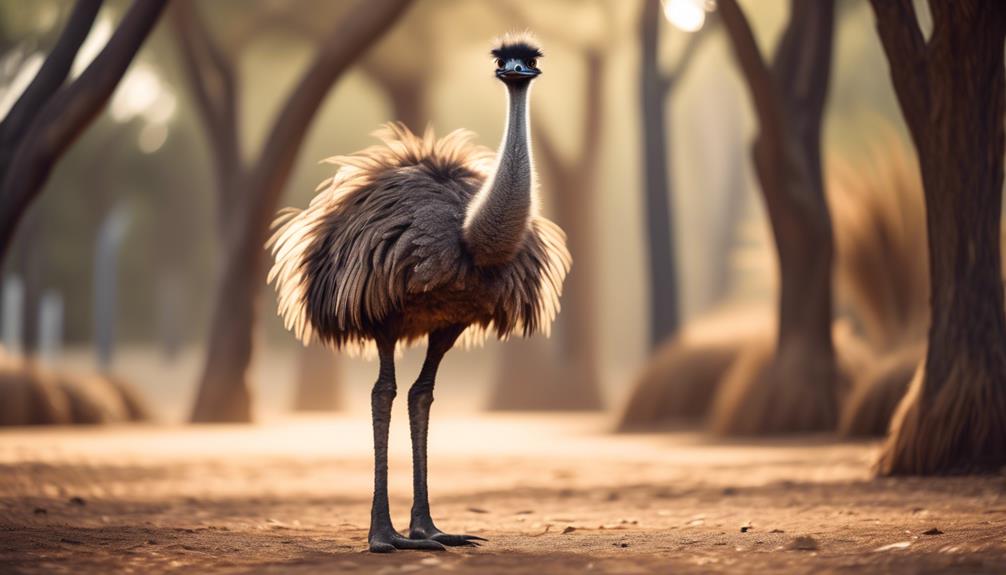
Emus are large flightless birds known for their impressive size and distinctive physical features. Their evolutionary history can be traced back to the ancient supercontinent Gondwana, where their ancestors originated around 80 million years ago. These magnificent creatures have adapted to a wide range of habitats, from dense forests to arid grasslands, showcasing their remarkable ecological role as keystone species.
One of the most striking aspects of emus is their size. Standing at an average height of 5 to 6 feet, they're the second tallest living bird species in the world, surpassed only by their close relative, the ostrich. Their long legs, equipped with powerful muscles, enable them to run at speeds of up to 30 miles per hour, making them superb runners and efficient foragers. Their plumage ranges from dark brown to greyish-brown, providing excellent camouflage in their natural habitats.
Emus possess unique physical adaptations that aid their survival. Their wings may be small, but they're strong and equipped with sharp claws, enabling the birds to defend themselves against predators and also assist in courtship displays. Their slender, elongated necks allow them to reach vegetation at varying heights, while their beaks are specialized for grazing, plucking fruits, and catching insects.
Skeletal Structure and Adaptations
Having explored the size and physical appearance of emus, let's now examine their skeletal structure and the unique adaptations that contribute to their remarkable survival.
Emus possess a skeletal system that's specifically designed to support their large bodies and enable them to adapt to their environment.
One of the key skeletal adaptations of emus is their strong and flexible spine. The spine of an emu is composed of numerous vertebrae, which allows for a remarkable degree of flexibility. This flexibility enables emus to maneuver through dense vegetation, making them well-suited to their natural habitat. Additionally, the flexibility of their spine allows emus to perform their distinctive running and kicking behaviors, which are essential for defense and communication.
Emus also have strong leg bones that support their weight and provide stability during movement. Their leg bones are adapted for endurance and can withstand the stress of long-distance running. This is crucial for emus, as they're known for their ability to travel significant distances in search of food and water.
Furthermore, emus possess specialized adaptations in their feet and toes. Their feet are equipped with strong and flexible tendons that act as shock absorbers, reducing the impact on their skeletal system when running or walking on various terrains. The toes of emus are long and sturdy, providing balance and traction.
Feathers and Plumage
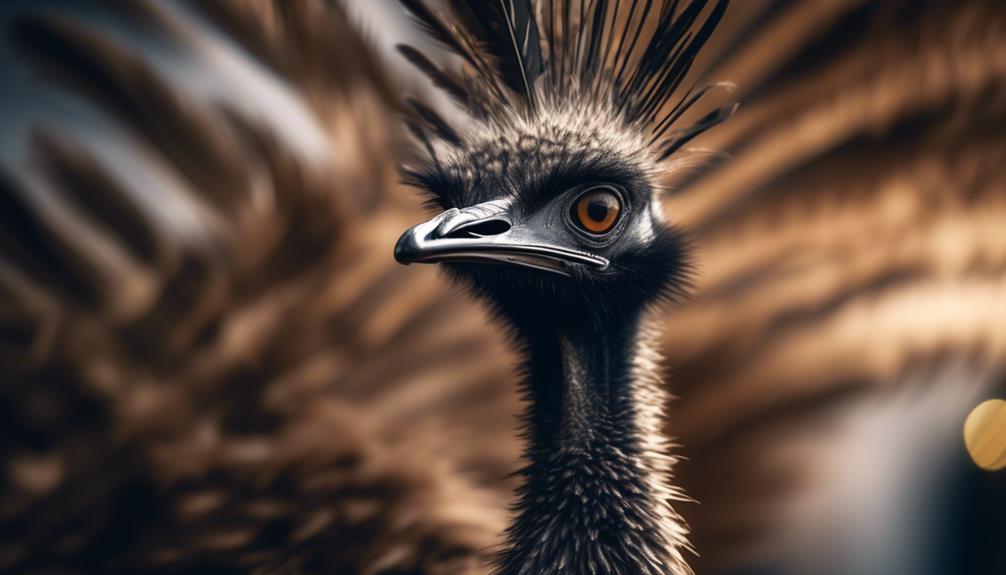
Feathers and plumage play a crucial role in the anatomy of the emu, contributing to its unique characteristics and survival strategies. The emu's feathers aren't only essential for flightlessness but also provide insulation, protection, and communication.
Here are some fascinating facts about emu feathers:
- Emu molting: Like other birds, emus go through molting, a process of shedding old feathers and replacing them with new ones. Molting allows emus to maintain healthy feathers, ensuring optimal insulation and protection.
- Feather coloration: Emu feathers are primarily brown, but they can have variations in color, ranging from dark brown to grayish-brown. This coloration helps the emu blend into its natural environment, providing camouflage and protection from predators.
- Filoplumes: Emus possess specialized feathers called filoplumes, which are small, hair-like feathers that act as sensory receptors. These filoplumes help the emu sense changes in its surroundings, such as changes in air pressure or movement.
- Double-barb feathers: Emu feathers have a unique structure with double-barbs, giving them a fringed appearance. This structure enhances the feather's ability to trap air, providing insulation and aiding in temperature regulation.
- Plumage display: During courtship, male emus display their plumage to attract females. They extend their feathers, revealing intricate patterns and vibrant colors, signaling their health and fitness as potential mates.
Emu feathers are a remarkable adaptation that allows these birds to thrive in their environment. Their molting process, feather coloration, specialized filoplumes, unique feather structure, and plumage display all contribute to their survival and reproductive success.
Unique Wing Characteristics
The wing of an emu exhibits unique characteristics that contribute to its adaptation for flightlessness and other survival strategies. Emus are large, flightless birds native to Australia, and their wings have evolved to serve different purposes than those of birds capable of flight. Emu wings are relatively short and stubby compared to their body size, and they lack the strong muscles and streamlined shape necessary for sustained flight. Instead, their wings are more adapted for balance and maneuverability on the ground.
The structure of an emu's wing reflects its flightless nature. The bones of the wing are reduced in size and fused together, resulting in a rigid structure that can't generate the necessary lift for sustained flight. The reduced size of the wing also means that emus lack the wing area required for generating enough lift to overcome their body weight.
While emus may be flightless, their wings still serve important functions in their daily lives. The wings are covered in soft, fluffy feathers that help to regulate body temperature and provide insulation. Additionally, emus use their wings for balance and stability while running at high speeds. By extending their wings slightly, they can adjust their center of gravity and maintain balance, enabling them to navigate through different terrains with agility.
Remarkable Beak and Mouth
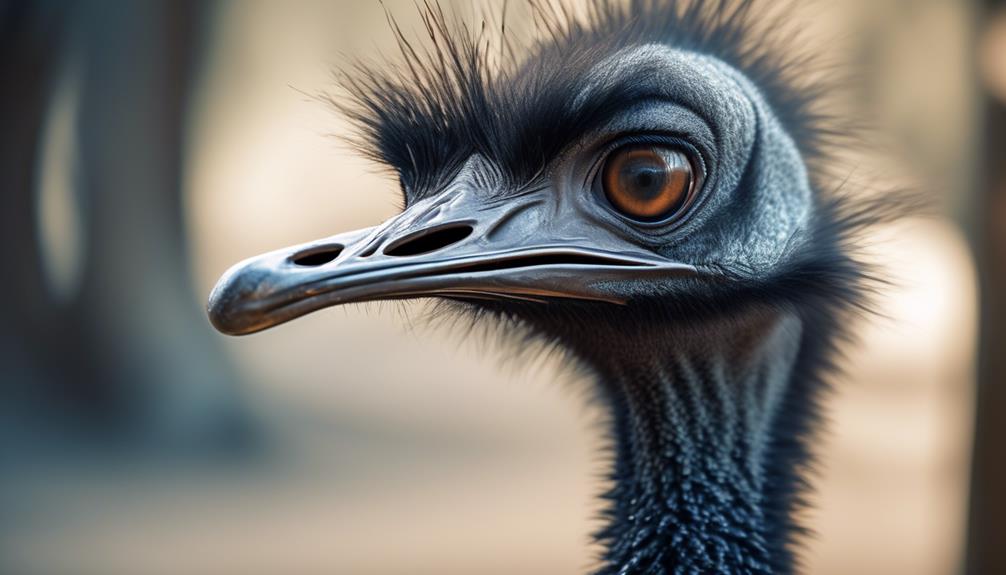
With its long, slender shape and sharp, pointed tip, the beak of an emu is a remarkable adaptation that plays an essential role in its foraging and feeding behaviors. The emu's beak is highly flexible, allowing it to manipulate and grasp various types of food.
Here are some key features of the emu's beak and mouth that contribute to its unique feeding habits:
- Beak flexibility: The emu's beak is extremely flexible, allowing it to bend and twist in different directions. This flexibility enables the emu to access food sources in hard-to-reach places, such as crevices in tree bark or narrow gaps between rocks.
- Sharp beak tip: The pointed tip of the emu's beak is ideal for probing and pecking. It allows the bird to easily pick up small insects, seeds, and fruits from the ground or from plants.
- Powerful jaw muscles: The emu has strong jaw muscles that enable it to exert significant force while feeding. This allows the bird to crack open tough nuts or shells to access the nutritious contents inside.
- Sensitive beak: The emu's beak is highly sensitive to touch and pressure. This sensitivity helps the bird identify and select suitable food items, ensuring efficient feeding.
- Dual-purpose beak: The emu's beak serves both as a tool for feeding and as a weapon for defense. Its sharp tip and strong beak muscles make it capable of delivering powerful pecks and bites to potential threats.
Legs and Locomotion Abilities
Utilizing their powerful lower limbs, emus exhibit remarkable locomotion abilities that contribute to their exceptional adaptability in various habitats. Their leg structure is specifically designed for efficient and agile movement, allowing them to run at impressive speeds.
The legs of an emu are long and sturdy, providing them with a stable base for their large bodies. This enables them to traverse different types of terrain, from grasslands to woodlands and even deserts. Their legs are covered in scales, which offer protection and aid in heat dissipation. The emu's toes are also unique, with three forward-facing toes equipped with sharp claws that assist in traction and stability while running.
Emus are renowned for their running speed, reaching up to 30 miles per hour. This impressive speed allows them to evade predators and cover large distances in search of food and water. Their long stride and powerful leg muscles enable them to take large, swift steps, propelling them forward with efficiency.
To better understand the emu's remarkable locomotion abilities, refer to the table below, which highlights their leg structure and running speed:
| Leg Structure | Running Speed |
|---|---|
| Long and sturdy | Up to 30 mph |
| Scaled legs for protection and heat dissipation | |
| Three forward-facing toes with sharp claws |
Specialized Digestive System
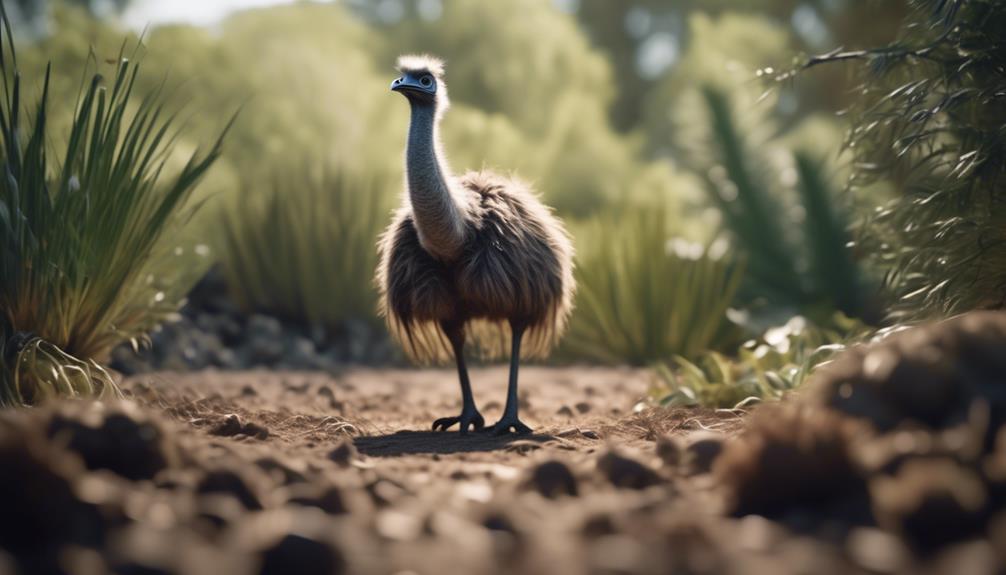
Emus possess a highly specialized digestive system that enables them to efficiently extract nutrients from the plant-based diet they consume. This unique digestive system is a result of their evolutionary adaptations to their specific diet and lifestyle.
- Emu diet: Emus primarily consume a diet consisting of plant material such as grasses, leaves, seeds, and fruits.
- Digestive adaptations: Emus have developed specific adaptations to break down and extract nutrients from the tough, fibrous plant material they consume.
- Fermentation process: Emus utilize a fermentation process in their digestive system to aid in the breakdown of complex carbohydrates found in their plant-based diet.
- Unique gut bacteria: Emus have a diverse population of gut bacteria that assist in the fermentation process and aid in the digestion of plant material.
- Crop and gizzard function: Emus have a crop and gizzard in their digestive system, which help with the mechanical breakdown of food before it enters the stomach.
Furthermore, emus also have hindgut fermentation, which allows for further digestion and absorption of nutrients. Their specialized enzymes play a crucial role in breaking down complex carbohydrates, proteins, and fats. This intricate digestive system ensures that emus efficiently absorb the necessary nutrients from their diet to support their growth and energy requirements.
Sensory Organs and Perception
As we move from exploring the specialized digestive system of emus to understanding their sensory organs and perception, it becomes evident that these remarkable birds have evolved intricate mechanisms to navigate and interact with their environment. Emus possess a range of sensory abilities that allow them to gather information and make sense of their surroundings.
One of the most notable sensory organs of emus is their eyes. With large, keen eyesight, emus are able to detect movement and spot potential threats or prey from a distance. Their eyes are positioned on the sides of their head, giving them a wide field of vision, allowing them to scan their surroundings for any signs of danger or opportunities for food.
In addition to their visual perception, emus also have a highly developed sense of hearing. Their ears are small and located on the sides of their head, covered by feathers. Despite their size, emus are able to detect low-frequency sounds, which is crucial for their survival in their natural habitat. This sensory ability allows them to listen for the calls of other emus or the sounds of approaching predators, enabling them to respond accordingly.
Furthermore, emus possess a well-developed sense of touch. Their beak is highly sensitive and can detect subtle vibrations in the ground, which helps them locate food sources like insects or small reptiles. Additionally, emus have sensory receptors in their feet, which allow them to navigate different terrains with precision and balance.
Reproductive System and Behavior
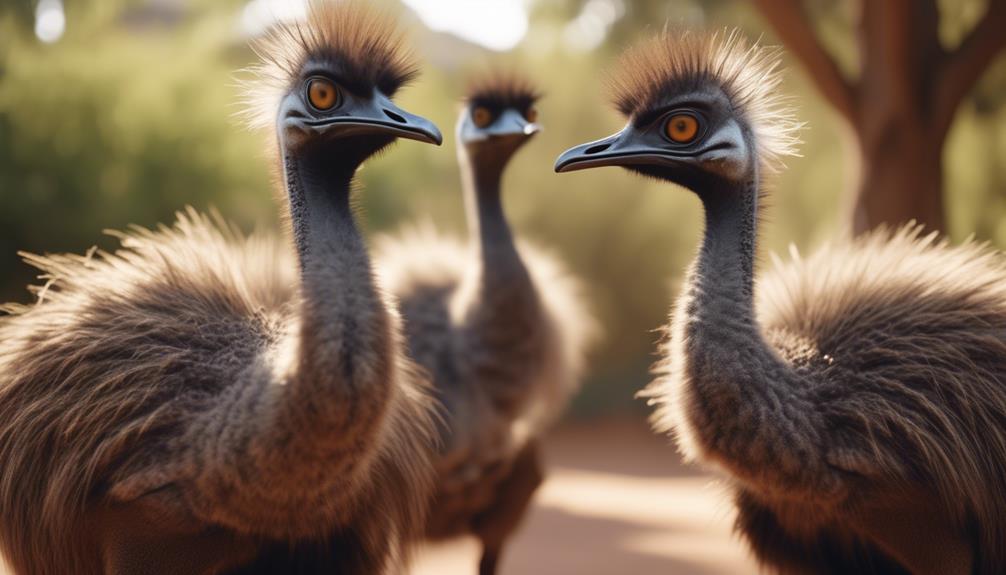
The reproductive system and behavior of emus play a crucial role in their species' survival and propagation. These fascinating birds have unique reproductive cycles and complex courtship rituals that ensure successful breeding. Here are some key aspects of the emu's reproductive system and behavior:
- Reproductive Cycles: Emus have a breeding season that typically occurs during the cooler months. Females reach sexual maturity around two years of age, while males become sexually mature around three years of age. During the breeding season, females lay a clutch of dark green eggs, usually around 9 to 12 eggs per clutch.
- Courtship Rituals: Emus engage in elaborate courtship displays to attract mates. The male will puff up his body, spread his wings, and emit deep booming calls to attract the attention of females. He'll also perform a unique dance, swaying his body from side to side and shaking his feathers to impress the female.
- Pair Bonding: Once a pair has formed, they'll remain together for the duration of the breeding season. The male will guard the female and the nest, while the female takes on the responsibility of incubating the eggs.
- Incubation: The female emu takes sole responsibility for incubating the eggs, which takes around 50 to 60 days. During this time, she rarely leaves the nest, relying on her mate to bring her food.
- Parental Care: After hatching, the male emu takes on the role of caring for the newly hatched chicks. He'll protect them, teach them how to forage for food, and provide them with warmth and shelter.
Understanding the reproductive system and behavior of emus sheds light on their unique characteristics and the intricate processes involved in their survival and propagation.
Frequently Asked Questions
How Long Can Emus Fly For?
Emus, with their flightless nature, are unable to fly. This lack of flight is advantageous as it allows them to focus on their diet preferences, which include plants, fruits, and insects.
What Are the Different Colors of Emus?
Emu color variations are fascinating. The genetics behind their hues is complex. From shades of brown to gray, emus display a range of colors. Understanding the intricacies of their pigmentation adds to the allure of these unique birds.
Do Emus Have Any Unique Vocalizations?
Emu communication is fascinating. These birds have unique vocalizations that are essential for social interactions, mating, and warning signals. Their deep booming calls and drum-like sounds are distinctive and can be heard from miles away.
How Fast Can Emus Run?
Emus, known for their unique anatomy, can reach remarkable speeds. They can run up to 30 miles per hour, making them one of the fastest birds on land. Imagine keeping such a swift creature as a pet or using their feathers for fashion.
How Many Eggs Do Emus Typically Lay in a Breeding Season?
On average, emus lay around 5-15 eggs in a breeding season. These eggs are quite large, weighing about 450-600 grams. It takes approximately 50-60 days for emu eggs to hatch.
Conclusion
In conclusion, the emu is a fascinating creature with a multitude of unique features.
From its impressive size and physical appearance to its specialized skeletal structure and adaptations, every aspect of the emu's anatomy is designed for survival in its natural habitat.
Its feathers and plumage provide both insulation and camouflage, while its remarkable wing characteristics enable it to navigate through the air with ease.
With its remarkable beak, legs, and specialized digestive system, the emu is truly a marvel of nature.
Its sensory organs and reproductive system further contribute to its success in the wild.
The emu's anatomy is a testament to the wonders of evolution and adaptation.




